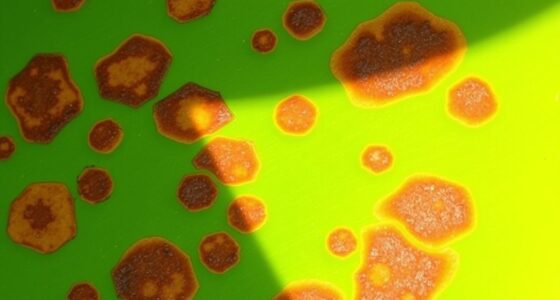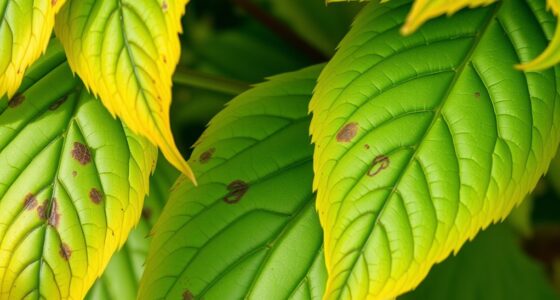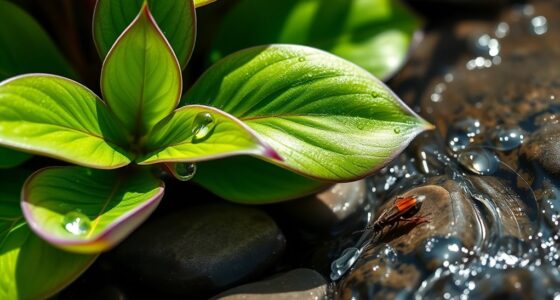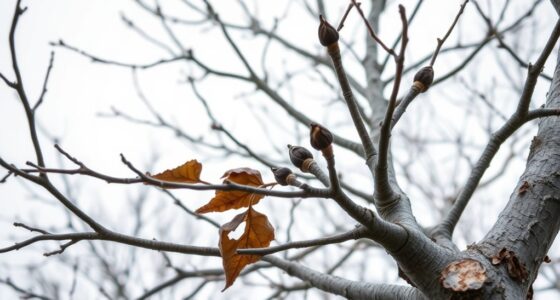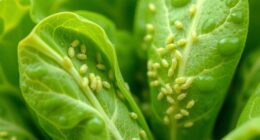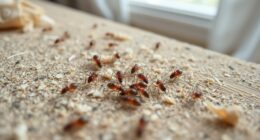If you notice black or sunken spots, rough or cracked bark, and areas that ooze or change texture, you might be dealing with canker. Moss appears as soft, velvety green patches that don’t harm but indicate excess moisture. Verticillium wilt causes wilting, discoloration, and branch dieback, often confirmed inside the trunk. Understanding these signs helps you identify the problem—continue exploring to learn effective ways to manage and prevent these issues.
Key Takeaways
- Canker appears as sunken, cracked, or rough bark lesions often with oozing; moss forms soft, velvety green patches on bark surface.
- Verticillium wilt causes irregular wilting, leaf discoloration, and internal dark streaks, usually without prominent bark damage.
- Moss thrives in high humidity, spreading horizontally or forming blankets, and indicates moisture issues rather than internal decay.
- Sunken, cracked bark suggests canker; surface moss without bark damage points to surface growth; wilt symptoms hint at verticillium.
- Proper diagnosis involves examining bark texture, color changes, and symptoms, then implementing targeted pruning, soil management, or fungicide treatment.
Recognizing Symptoms of Fungal Issues on Japanese Maples

Fungal issues on Japanese maples often reveal themselves through noticeable changes in the leaves, stems, or bark. You might see spots, discoloration, or wilting on the leaves, indicating possible infection. When inspecting your tree, consider how tree pruning might have affected its defenses; improper pruning can create entry points for fungi. Additionally, soil health plays a vital role—poor soil can weaken your maple’s immune system, making it more susceptible. Look for signs of decay on stems or bark, such as soft spots or unusual growths. Maintaining proper pruning techniques and ensuring healthy soil can help prevent fungal problems. Regularly check your tree’s condition, and act promptly if you notice symptoms, as early detection is key to managing fungal issues effectively. Proper textile techniques can also assist in protecting your trees from environmental stressors that favor fungal development. Implementing preventative measures such as mulching and proper watering can further strengthen your Japanese maple against these issues. Being aware of specific fungal pathogens that commonly affect Japanese maples can aid in early identification and targeted treatment.
Differentiating Between Canker and Other Bark Diseases

To tell canker apart from other bark diseases, start by examining the visible symptoms and signs on your maple. Pay close attention to changes in bark texture and color, as these can indicate different issues. Watching how the disease progresses over time helps you identify whether it’s canker or another bark problem. Recognizing the disease progression pattern can provide critical clues for accurate diagnosis. Additionally, understanding the symptoms of fungal infections can help differentiate between types of bark diseases and determine appropriate treatment options.
Visible Symptoms and Signs
When examining a Japanese maple for signs of disease, distinguishing between canker and other bark issues is essential. Look for leaf discoloration, which often indicates systemic health problems like root rot, rather than localized bark damage. Cankers typically present as sunken, discolored lesions on the trunk or branches, sometimes with cracked or oozing bark. In contrast, moss or other surface growths usually appear as fuzzy or green patches without tissue death. If you notice areas where leaves are yellowing or falling prematurely, it may suggest underlying root rot affecting nutrient flow. Early signs of canker include darkened, sunken areas, while other issues may show more superficial symptoms. Recognizing these signs helps you determine the underlying problem accurately. Additionally, understanding the rustic charm of the tree can aid in identifying the proper treatment to restore its health. Proper tree diagnosis is crucial for effective intervention and long-term recovery.
Bark Texture and Color
Distinguishing between canker and other bark diseases relies heavily on examining the texture and color of the affected areas. Cankers often cause sunken, cracked bark with rough, irregular bark texture, and may exhibit dark or discolored patches. In contrast, moss appears as soft, velvety green growth, usually not altering bark texture considerably. Verticillium wilt rarely affects bark color but may cause subtle changes like pale streaks or fading. Here’s a quick comparison: Anti-aging effects from eye patches can smooth fine lines and improve skin appearance, but they are not a substitute for medical treatment. Recognizing these visual cues can help in early diagnosis and effective management of the disease.
Disease Progression Patterns
Understanding how bark diseases develop over time helps you identify them more accurately. Canker usually appears as sunken, dead areas on the trunk that expand gradually, often with cracked or peeling bark. In contrast, Verticillium wilt causes wilting and discoloration that spread irregularly, without clear borders. Moss, on the other hand, typically grows slowly on the surface, not indicating internal decay. Monitoring these patterns helps you differentiate disease progression. Proper pruning techniques can prevent further damage, removing infected tissue early. Improving soil health with appropriate amendments boosts the tree’s immune response, reducing susceptibility. Recognizing these progression patterns allows you to act promptly, applying targeted treatments or consulting an arborist before the disease worsens. Additionally, understanding the disease progression patterns of bark diseases can help you implement effective preventative measures to protect your Japanese Maple. Being aware of symptom development assists in early detection and more successful intervention.
Identifying Verticillium Wilt in Japanese Maples

How can you tell if your Japanese maple is suffering from Verticillium wilt? Look for wilting leaves, especially on one side of the tree, and early leaf browning that doesn’t improve. You might notice dieback of branches or sudden decline in overall vigor. To confirm, check soil health—poor soil can stress the tree, making it more susceptible. Verticillium affects the vascular system, so healthy pruning techniques are essential; avoid wounding the tree unnecessarily, as cuts can serve as entry points for infection. Also, look for dark streaks inside cut branches or trunks, which indicate infection. Regular monitoring and maintaining ideal soil conditions help you catch symptoms early, giving your Japanese maple the best chance to recover. Additionally, understanding plant disease diagnosis can help you differentiate between fungal infections and other issues like canker or moss. Being aware of growing conditions that promote disease development can further aid in prevention.
How to Spot Moss and Its Role on Tree Trunks

While spotting signs of disease like Verticillium wilt is vital for your Japanese maple’s health, it’s also important to keep an eye out for moss growing on the trunk. Moss identification is straightforward: it appears as soft, green or grayish patches that cling to the bark’s surface. Usually, moss thrives in areas with high bark moisture, which provides the damp environment it needs to grow. You’ll notice it spreading horizontally or forming blanket-like layers on the trunk. While moss isn’t directly harmful, excessive moisture can indicate underlying issues like poor drainage or persistent humidity. Regularly inspecting your tree for moss helps you understand its moisture levels and catch potential problems early, ensuring your Japanese maple stays healthy and vibrant.
Causes and Conditions Favoring Fungal Growth on Tree Bark

Fungal growth on your Japanese maple often starts when moisture lingers on the bark, especially after rain or overwatering. Damaged or wounded bark provides an easy entry point for fungi to infect the tree. Poor air circulation around the trunk also creates a humid environment that encourages fungal development. Additionally, WWE Raw’s financial impact underscores the importance of understanding environmental factors, as they can significantly influence plant health and disease development. Utilizing AI-powered analysis can help identify early signs of fungal issues and inform effective treatment strategies.
Excessive Moisture Levels
Excessive moisture levels create an ideal environment for fungal growth on Japanese maple bark. Poor soil drainage can cause water to pool around the roots, keeping the bark consistently damp and encouraging fungi to thrive. Overwatering or frequent rain can also increase humidity on the trunk surface, especially if airflow is limited. Additionally, improper pruning techniques that leave wounds or reduce airflow can trap moisture around the bark, further promoting fungal development. To reduce this risk, ensure your soil drains well and avoid overwatering during rainy periods. Proper pruning improves airflow around the trunk, helping it stay drier and less hospitable to fungi. Keeping moisture levels balanced is key to preventing fungal infections and maintaining a healthy Japanese maple. Implementing proper care strategies can further help in creating a less conducive environment for fungi, including managing moisture levels effectively.
Bark Damage and Wounds
Damage to the bark from wounds or injuries provides an entry point for fungi to infect Japanese maples. When the bark is damaged, it creates an open door for fungal spores, especially if soil health isn’t ideal or pruning techniques are careless. Proper pruning helps prevent unnecessary wounds and reduces infection risk. Poor soil conditions can weaken the tree’s defenses, making it more susceptible to fungal growth on bark. Keep an eye out for these risk factors:
- Improper pruning that leaves jagged cuts
- Mechanical damage from lawn equipment
- Insect activity creating entry points
- Soil compaction stressing roots
- Cracks from temperature fluctuations
Maintaining good soil health and careful pruning techniques minimizes bark wounds, ultimately reducing fungal invasion opportunities.
Poor Air Circulation
Poor air circulation around Japanese maples creates an environment where moisture can linger on the bark, encouraging fungal growth. When air doesn’t move freely, humidity remains high, providing ideal conditions for fungi to thrive. To prevent this, you should prune surrounding plants and remove debris that blocks airflow. Proper pruning also improves air circulation within the canopy, reducing moisture buildup. Ensuring good airflow is a simple yet effective step in fungal prevention, helping your tree stay dry and healthy. Avoid overcrowding trees or planting them too close to structures, as this can restrict airflow further. Regularly inspecting your Japanese maple for signs of excess moisture and improving air circulation will go a long way in keeping fungal infections at bay. Additionally, understanding the types of fungi that affect Japanese maples can help in early identification and targeted treatment. Promoting good air circulation is essential for drying out the bark and preventing the development of fungal infections, which can compromise the health of your tree.
Effective Treatment Methods for Canker and Fungal Infections

To effectively treat canker and fungal infections in Japanese maples, it’s essential to act promptly and choose the right methods. Start by removing affected areas using proper pruning techniques to prevent the spread. Disinfect tools between cuts to avoid contamination. Improve soil management by ensuring well-draining soil and avoiding excess moisture, which fuels fungi. Apply fungicides labeled for maples, following instructions carefully. Keep the trunk and base clear of debris to reduce infection risks. Regularly inspect your tree for early signs of trouble and maintain good airflow around the canopy. Consider mulching to protect roots and support overall health. These steps help control infections and promote a stronger, disease-resistant tree.
Preventative Practices to Maintain Healthy Japanese Maples

Maintaining healthy Japanese maples requires proactive care habits that prevent infections before they start. Start by improving your soil with appropriate amendments, such as organic compost or well-draining materials, to promote strong root systems and overall vigor. Healthy roots help resist disease and reduce stress. Use proper pruning techniques to remove dead or damaged branches early, ensuring good air circulation and minimizing fungal growth. Always sterilize pruning tools to prevent spreading pathogens. Avoid overwatering and ensure proper drainage, as excess moisture encourages fungal development. Mulching around the base can help maintain consistent soil moisture and temperature. Regularly inspect your tree for early signs of trouble, and address minor issues promptly to keep your Japanese maple resilient against fungus and other problems.
When to Seek Professional Assistance for Trunk Fungi

Recognizing when to seek professional help for trunk fungi is essential to prevent further damage to your Japanese maple. If you notice persistent cankers, oozing wounds, or widespread moss growth, it’s time to consult an expert. They can evaluate the health of your tree and recommend proper pruning techniques to remove infected tissue safely. Professionals can also advise on soil amendments to improve drainage and strengthen your tree’s defenses. Don’t delay if you see signs of decline or if the fungus appears to spread. Early intervention can save your Japanese maple from severe damage or death.
Seek professional help early to prevent Japanese maple trunk fungi from causing severe damage.
Consider seeking help if:
- Cankers enlarge despite pruning efforts
- Wounds don’t heal
- Moss covers most of the trunk
- You’re unsure about proper pruning techniques
- Soil health seems poor or stagnant
Frequently Asked Questions
Can Fungi on Japanese Maple Trunks Be Harmful to Surrounding Plants?
Fungi on Japanese maple trunks can pose risks to surrounding plants through fungal spread, potentially affecting their health. While some fungi are harmless, others may produce spores that travel and infect nearby plants, leading to disease or decline. You should monitor the fungi closely, remove infected material, and maintain good plant hygiene to protect your garden’s overall plant health. Acting promptly can prevent fungi from harming surrounding plants.
Are There Natural Remedies to Prevent Fungal Growth on Japanese Maples?
You can prevent fungal growth naturally by using organic sprays like neem oil or copper-based solutions, which help inhibit fungi on your Japanese maple. Additionally, introducing beneficial fungi to the soil can boost your tree’s immune system and outcompete harmful pathogens. Regularly prune dead or infected branches, keep the area clean, and avoid overwatering. These organic methods promote a healthy, resilient tree without relying on chemicals.
How Long Does It Take for Fungal Infections to Damage the Tree Significantly?
Coincidences often reveal how quickly fungal progression can threaten your tree. If left untreated, fungal infections may cause noticeable tree deterioration within a few months, but some damage can take years to become severe. The rate depends on the fungus type and environmental conditions. Early detection and treatment are vital; otherwise, the infection may weaken the tree, risking structural failure and eventual death.
Can Pruning Help Control or Prevent Fungal Issues on the Trunk?
Pruning can be an effective way to control or prevent fungal issues on the trunk if you use proper pruning techniques. By removing infected or dead wood, you improve airflow and reduce moisture, which helps prevent fungi from taking hold. Regular, careful pruning promotes fungal prevention and keeps your tree healthy. Just make sure you sterilize your tools and avoid cutting during wet conditions to prevent spreading fungi.
Is There Seasonal Variation in Fungal Infections on Japanese Maples?
Have you noticed changes in your Japanese maple’s health during different seasons? Seasonal patterns can influence fungal prevalence, with infections often more common in humid, wet seasons like spring and fall. Warmer, dry periods may reduce fungal activity. Understanding these patterns helps you plan timely pruning and treatments. Are you observing more issues during certain times of the year? Recognizing seasonal variation allows you to better protect your tree year-round.
Conclusion
By regularly inspecting your Japanese maple, you can catch fungal issues early—like uncovering a hidden threat beneath the bark’s surface. Imagine the trunk as a fortress, vulnerable to unseen invaders like canker, verticillium, or moss. With attentive care and prompt action, you can keep your tree resilient and vibrant, preventing these fungi from silently turning your beautiful maple into a battleground. Stay vigilant, and your tree will thank you with lasting grace.


